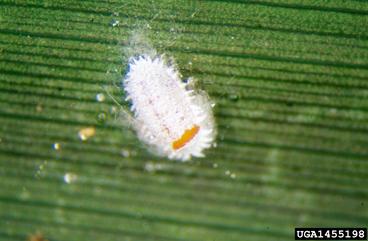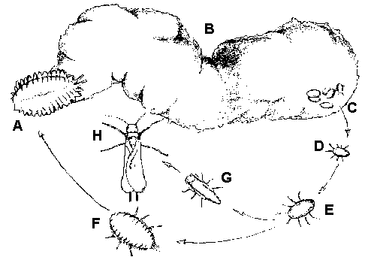SCIENTIFIC NAME: Planococcus citri (Risso)
CLASS: Insecta
ORDER: Hemiptera
FAMILY: Pseudococcidae
Description
Adults
The female citrus mealybug is wingless and appears to have been rolled in flour (hence the name). It grows to 3 millimeters long and 1.5 millimeters wide. A fringe of small waxy filaments protrudes from the periphery. The male is small, but with its wings and tail filaments, it appears to be 4.5 millimeters long.


Eggs
The oblong, yellow eggs are enmeshed in a dense, fluffy, white ovisac.
Crawlers
The tiny crawler is oval and yellow, with red eyes. The antennae are rather distinct.
Nymphs
Female nymphs resemble the larger adult females. Male nymphs are narrower and often occur in a loose cocoon.
Biology
Host Plants
Citrus mealybugs have been collected from at least 27 host plant families. Many ornamental plants grown in greenhouses are susceptible to attack including begonia, coleus, amaryllis, cyclamen, and dahlia. Citrus mealybug has been collected on canna, narcissus, and tulip outdoors.
Damage
Citrus mealybugs damage hosts by sucking out plant sap, by secreting honeydew in which sooty mold can grow, and by causing distorted growth and premature leaf drop with their toxic saliva. They further disfigure plants by secreting cotton wax. Infested plants usually die unless the pest is controlled.
Life Cycle
The citrus mealybug has been recognized as a pest of citrus and ornamental plants in Europe since 1813 (where it is called the greenhouse mealybug) and in the United States since 1879. Because female citrus mealybugs have no wings, the must be transported to the proximity of the next host plant. They can, however, travel short distances by crawling. The immatures can be blown about. Males are small, winged insects. After mating, each female lays hundreds of eggs in a dense, fluffy secretion called the egg sac or ovisac. Within a few days, new mealybugs (crawlers) hatch and begin to squirm out of the ovisac. Light infestations are easily overlooked because the mealybugs tend to wedge into crevices on the host plant. As their numbers increase, mealybugs of all sizes can be seen crawling around or feeding on all exposed plant surfaces.
Management Strategies
Control of citrus mealybugs is extraordinarily difficult. Some commercial flower growers merely discard infested plants rather than trying to rescue them from citrus mealybugs. Horticultural oils may damage amaryllis.
Biological Control
The lady beetle Cryptolaemus montrouieri and parasitic wasps Leptomastix dactlopii and Anagrus pseudococci attack citrus mealybugs.